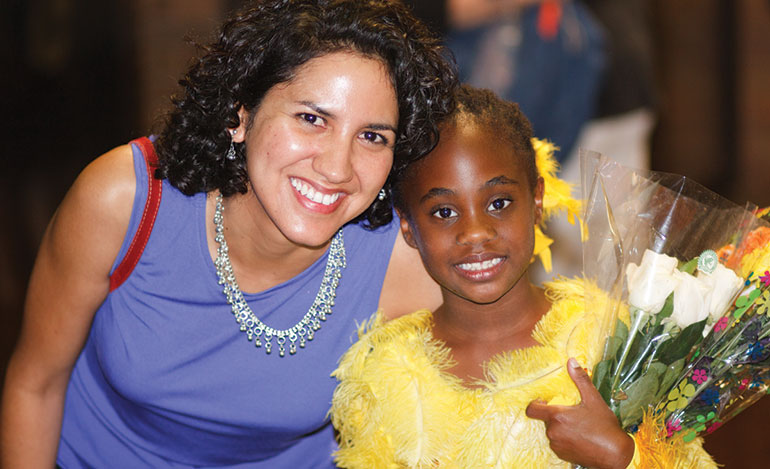There was almost a riot at the ballet studio. There were angry mothers, threatening to pull their daughters out of the recital with less than three weeks to go. There was talk of asking for tuition money back. There were countless grumbles of discontent. What incited all this? A bun.
There are several dance studios in our town, but only one that teaches ballet exclusively. Because ballet has traditionally been an art pursued by white people, the majority of girls enrolled at this studio have been white. That’s why we bypassed it when we began looking at studios for our daughter, Isabel. We didn’t want her to be the only African-American in her dance class. But after a miserable experience at a more diverse studio, we decided to reconsider.
This studio treats classical ballet as an art, rather than as a form of entertainment for the parents. We wanted Isabel to learn the discipline, hard work, and skills of the dance form, not just a routine for a final performance.
When it came time to enroll, we were pleased to discover that, in one year, the face of the studio had altered dramatically. In Isabel’s class, half of the girls were children of color. In fact, the culture of ballet is changing, too, with more ballerinas of African descent gracing the world’s stages.
“No braids, please”
Of course, with diversity come some cultural differences — and misunderstandings. This is where the bun comes in. The recital was three weeks away. During one of the rehearsals, I was sitting in the lobby when the assistant director came out and said: “Would you make sure to tell the mothers of the other African-American girls to style their girls’ hair in smooth, sleek buns at the nape of the neck? No braids, please.”
I looked at her skeptically and said, “OK.” When some of the moms came into the lobby, I mentioned the request. The grumbling began.
“These directors don’t understand our hair!” one mother complained.
“I have an appointment right before the recital to have my daughter’s hair braided for vacation, and I can’t re-schedule!” moaned another.
Good hair, naturally
I posed the question about how to achieve a bun on the “Chocolate Hair/Vanilla Care” Facebook page. The response from my fellow adoptive mothers of black children was mixed. Several moms said the bun is just part of being a ballerina. Some who had older girls who had been dancing for years reported being asked to chemically straighten their daughters’ hair as part of their training. Many of them gave me tips on how to make a bun. Yet others raised their voices in outrage that we had to do it at all, that our girls were being forced to conform to white standards of beauty and elegance. They demanded recognition of the cultural and physical differences in hair and hair care.
Before adopting Isabel, I might have thought: “What’s the big deal?” But my perspective has changed since I started taking care of my daughter’s hair, and delving into African-American culture, values, and struggles, as well.
There is a movement in the black community toward keeping hair natural and shunning chemical relaxers. Take a look in the ethnic beauty section of your local Walmart or Target, and notice the increasing number of products for natural hair and the dwindling number of relaxers or products designed for permed hair. The number of blogs and Facebook pages dedicated to black natural hair care is also impressive. But styling a “sleek bun” would require us moms of young black girls to somehow straighten, and thus damage, their hair.
Our braided beauties
I felt caught in the middle. In every ballet I have ever seen, the dancers have worn their hair in buns, so I understood the requirement. But I couldn’t figure out how to accomplish this hairstyle on my daughter’s head. I had two choices: to find a way to create this bun and abide by the rules, or to reach out to the director and be an agent of change.
Never one to go down quietly, I composed an e-mail to the director. I explained the difficulties of achieving this hairstyle on my daughter and the other African-American girls, and also the lack of cultural awareness that this requirement betrayed. I described the feelings of discontent and exclusion it was creating among the mothers of our little black ballerinas. I said that we all appreciated the time and love she gave our children, but I reminded her that, as the studio becomes more diverse, this situation was sure to arise again.
The director replied with a sweet e-mail, stating that she simply hadn’t anticipated the stress the bun request would cause the mothers or the harm to the hair it would involve. She had no idea about black hair and was about to lose several clients because of this seemingly small oversight.
I say “seemingly” because hair is a big deal.
Yes, in ballet, it is traditional to wear a bun in performance. Yes, there are black ballerinas who straighten their hair to achieve this look. No, that is not the only way. As more people of color enter the world of classical ballet, maybe the tide will turn. There are elegant and culturally relevant styles of buns that make use of braids, and they can look as polished as the classic, sleek style.



